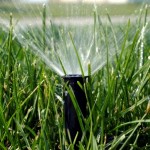Spring is the perfect time to get your lawn mower ready for the season. Regular tune-ups and maintenance can make your lawn mower last longer, perform better, and keep your lawn healthy and curb appeal friendly. Here are some tips on getting your lawn mower ready for spring.
1. Read the manual.
First, read the manufacturer’s maintenance instructions in your manual. Make sure the maintenance you are performing is recommended by the manufacturer for your specific lawn mower.
Also, if you’re not comfortable working on your lawn mower, get professional help, or ask a friend who’s more mechanically minded to help you out.
2. Get ready.
Work in a ventilated area. If you’re in the garage, open the overhead door for maximum ventilation. Get together the supplies that you’ll need, including a drop cloth, cleaning brush, work gloves, engine oil, and lubricant. You’ll also need a new spark plug and air filter, if your lawn mower uses a paper filter.
Cover the garage floor, driveway, or other work area with a drop cloth to protect the ground from any spills and to make cleanup easier.
3. Disconnect the spark plug.
Before you do any work on your lawn mower, disconnect the spark plug. This step is extremely important, since it prevents the lawn mower from accidentally starting while you are performing maintenance.
4. Clean it up.
Remove the grass catcher (if equipped) and brush away any dried grass clippings on the mower deck as well as underneath. You may need to use a putty knife to remove dried clods of grass and debris. If your lawn mower has a wash port built into the deck, we recommend cleaning your lawn mower after each use to make this step easier.
5. Replace the oil.
Change the oil by removing the drain plug at the bottom of the engine and allowing the dirty oil to run out into a container. Then put the plug back in place and add new engine oil. Choose the type of oil recommended in the owner’s manual for your lawn mower.
6. Sharpen the blade.
Did you know that a dull lawn mower blade can shred the tips of your grass and make your lawn turn brown? Sharpen the blade at least once a year. More often is better, but for most homeowners, once a year is better than never. Remove the blade from the mower before sharpening it. This is also a good time to thoroughly clean the underside of the mower, with the blade removed. If the blade has large nicks in it from hitting rocks or other debris, you should replace it with a new lawn mower blade.
7. Lubricate.
Lubricate the wheel bearings and any moving parts to keep them working smoothly. This also helps prevent rusting during storage.
8. Clean or replace the air filter.
Next, it’s time to clean or change the filter. If your lawn mower has a paper filter, replace the filter with a new one each mowing season. If your lawn mower has a foam filter, remove the filter and clean it with dish detergent and water. Then lightly saturate it with engine oil, wipe off the excess oil with a shop rag or plastic bag, and put the filter back in place.
If you see any wear or damage inside your air cleaner element, replace it immediately. If your air cleaner is faulty, you risk damaging the lawn mower engine—which is much more costly to fix.
9. Change the spark plug.
Finally, you’ll need to replace the spark plug. This ensures easy starting. Use a socket wrench to replace the spark plug. Then reconnect the wire. Your mower is now ready for the season!
Lawn Mowers for Sale
Need a new lawn mower for the season? MowerSource.com sells high quality Toro, Ariens, and Husqvarna lawn mowers, including riding mowers, self-propelled mowers, and zero turn mowers. Free shipping on all orders to the lower 48 U.S.










